|
Part 6b -
SINGPORE
[cont...]
’See you at Raffles’ :
catch phrase in the 1930’s era
15.3.07
Another amazing breakfast, I estimated 80 different dishes including 4
kinds of lychee. We didn’t even know there were
4 kinds of lychee.
Picked up at hotel [did I mention that's Raffles?]
for a Round the Island tour, excellent guide – Philip. First stop is
Haw Par Villa, a strange pleasure garden laid out by two wealthy
brothers to depict the ten stages of hell and other assorted goodies.
Later as they travelled the world, they added a statue representing each
place so among the Buddhist tableaux we come across a pair of black
swans [Perth,
Australia] and the Statue of Liberty. Everything seems to be made of cheap
plaster and is garishly painted. The stages of hell are lurid and
bloodthirsty, each scene out-doing the last for graphic gruesomeness.
There is a car made for one of the brothers from a converted Buick, with
a plaster tiger’s head where the bonnet should be, and the horn
growls! One of the brothers name translated to Tiger; so ok they had a
sense of humour. They’d need it, visiting this lot for pleasure. The
pleasure gardens were visited by the families of the brothers for many
years, but eventually they were donated to the public. Crafty move, the
tackiness must have become even more tacky and dilapidated until the
government restored it all. It’s still pretty tacky now.
Back in the coach, Philip speaks for a long time about the Japanese
invasion, the sufferings and atrocities of the armed forces and
civilians alike. He speaks quietly, unemotionally and openly, and quite
unremittingly. He tells stories of civilians being killed for bumping
into Japanese soldiers, one woman whose baby was bayonetted because she
stumbled against a Japanese soldier and grabbed him to steady herself
while carrying the baby. Philip said she went insane with grief. He told
of the Japanese Military Police, the Kampaitai, who sounded even more
brutal than the Gestapo if that’s possible. They routed out and took
away anyone who was anti Japanese, who might be anti, or who looked as if they might be. If a civilian
looked wrong to them, or looked at them in the wrong way, they were
taken away. People taken by the Kampaitai were never seen again.
With this prelude, we arrive at the Kranji War Memorial, a beautiful
setting for war graves which overlook the city the service men tried to
defend. It is immaculate. Many rows marked ‘known to God’ start me
off, and when we get to the top of the hill and find a series of huge
walls inscribed with the names of those killed whose bodies were never
found, we are both in tears. 24,000 names from the UK, Australia
and India. We are awash with grief.
The coach takes us to the Orchid Restaurant for lunch, a set meal which
is surprisingly good, served with green tea. A little oasis in the day.
We learn that the waiters are from
China, brought here because they will work for one tenth of the wages of
Singaporean staff, which is still more than they could earn at home in
China. As their room and board is included, they send most of their earnings
back to their families in China. Seems it is the same all over the world.
Next stop, Bright Hill - Kong Meng San Phor Kark See Monastery - a renovated and extended Buddhist
Temple
of great beauty, wonderfully colourful and the biggest in Singapore. The main Buddha, at a cost of
S$1, is probably the biggest I’ve ever seen, put in place before the
building was completed around it. The people meditating before it look
like dolls. There are 3 dharma halls each seating 1500 people, it should
be impersonal and yet it has a powerfully peaceful feel to it, as if we
are in seclusion away from the world.
The roofs are capped with dragons breathing fire, impressive seen from
ground level against the sky. The gardens are more restrained than the
buildings, with gentle lawns and small shrubs. There are vegetable
patches where the monks grow much of their own food. They are not
allowed to beg in the usual Eastern way. Philip told us if we see monks
begging for food, leave them alone, they are imposters who come in,
dress in robes in order to beg. If you give them $5, they say not
enough, the going rate is $10. Then you know they are false monks, monks
are not allowed to handle money.
The ‘cloisters’ are decorated with panels showing aspects of
‘filial duty’. I take a picture of one to let Ben know what he is in
for – a grown up son is trying to cheer up his depressed elderly
parents, he is rolling on the floor and playing with baby toys, rattles
etc. Ben knows what he has to do if we ever get depressed!! Fun. Better
than the picture of a starving family where the daughter in law is
breast feeding her husbands mother before she feeds her own baby –
eeeughhh, what a picture!!
Nearby is the crematorium, and a large building - a columbarium - to house the cremated
remains of Buddhists. It is full, and a second, equally large, has just
been built. Nothing is high rise in this enormous temple complex, it
must cover a lot of expensive real estate. Philip tells us that many
Singaporeans wish to be buried, but the cemeteries are full and now it
is only possible to bury your relatives for 8 years. Then you have to
exhume the remains and have them cremated, so the move is towards
cremation in the first place.
Land is at a premium here, and they are constantly reclaiming land from
the sea. Vast tracts already in use, Philip points out. They have
traditionally bought sand and earth from
Malaysia
to use in their reclamation, but
Malaysia
has now stopped selling, threatened by the increasing success of
Singapore
. So they have to look further afield for their raw materials, making it
more expensive. The Singaporeans seem resourceful and unafraid of taking
hard decisions, unlike our government. The result appears to be a much
more peaceful living together of diverse elements of community, as if
everyone knows the rules and lives within them. Penalties for wrong
doing are far more severe than in the UK, which is perhaps a help too. But people feel included and rub along
together. There are, for example, 4 official languages: English,
Mandarin, Malay and Tamil. Philip described an island nation which knows
what it has to do to survive, and just gets on with it. We seem arrogant
in comparison, perhaps we don’t see our survival being threatened and
so we stumble on, never really resolving our crises. Do we even have
a 20 year plan?
|
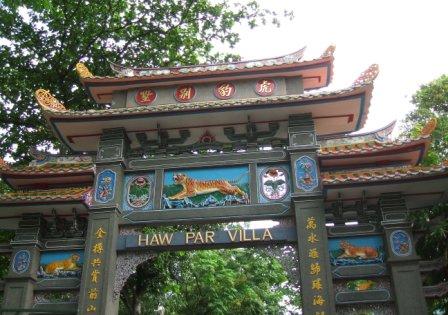
entrance to Haw Par
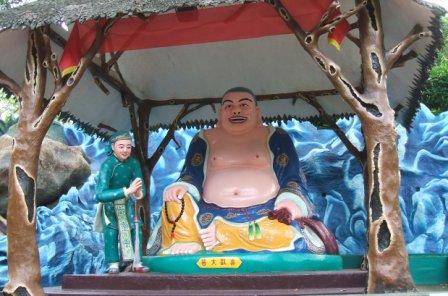
one of the more pleasant tableaux, the 'lucky' Buddha
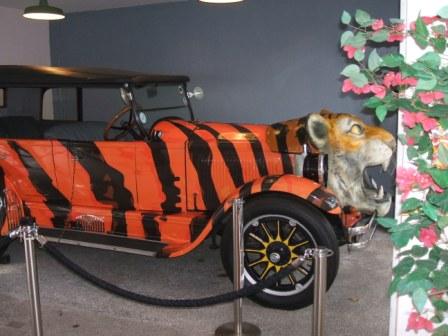
Tiger's Buick
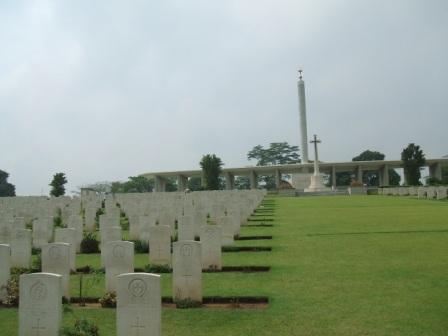
Kranji War Cemetery
War Graves: 'known to God'
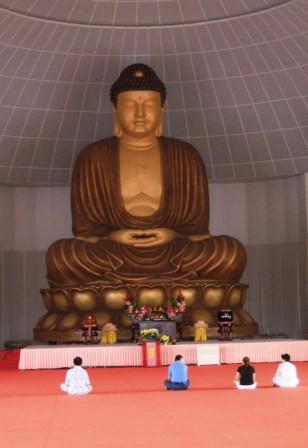
Golden Buddha
Bright Hill Temple
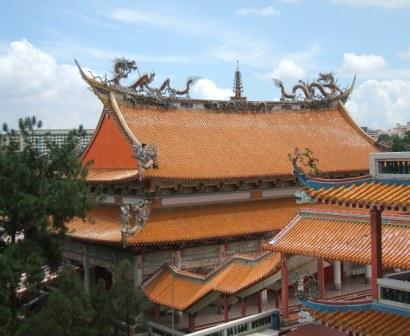
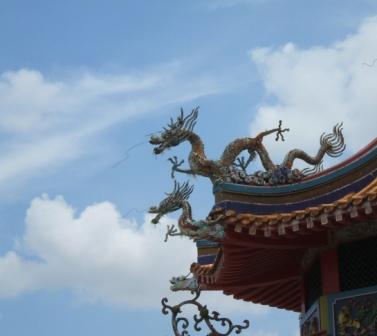
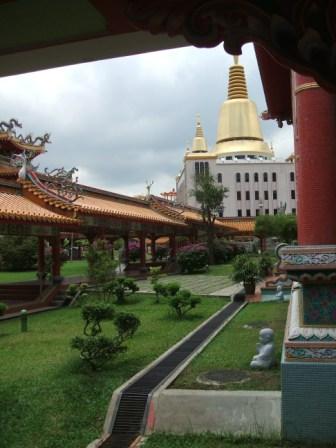
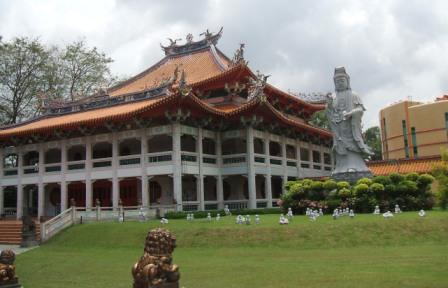
Kwan Yin
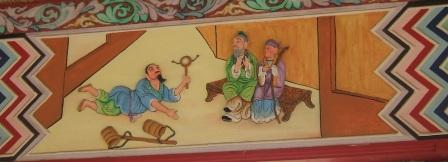
one of the panels illustrating 'filial duty'
|
|
Changi
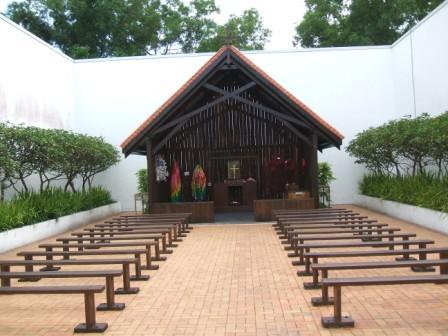
Moving on to our last stop of the tour, Philip speaks more about WW2,
and we arrive at Changi Chapel and Museum, next to Changi prison which
is still in operation. Only a derelict gate and tower from the original
notorious prison still stands, the rest gone, under protest, in the
renovation process of today’s prison. Philip says the chapel and
museum affect people differently so he doesn’t go in with us, and says
we must just come out when we want to. Some people can only get part way
round. It is unbearably moving. Much of the story of the Japanese
invasion is told in the words of people who went through it, service men
who became POW’s, and civilians. I can’t imagine how people ever
survived such brutality, or how anyone could inflict such brutality on
others. These are mysteries beyond my ken.
Changi Chapel: replica
of one built by Australian POW's
Out of respect, no photographs are allowed inside the Museum
Local people risked daily beatings or worse to help the POW’s housed
in Changi. One POW told of a woman who waited every morning outside the
gates for a work party to come through. She always had a little tray of
sweets and bits of food, not much, but some. The POW’s ate it quickly
before the Japanese could stop them, and each day the woman was beaten.
The men always expected she wouldn’t be there the next day, but she
always was. What simple courage. Any day she could have been killed but
to endure beatings willingly …. I feel humbled and unsure that I could
or would have knowingly submitted myself to that [but pretty certain
really that I wouldn’t].
The pictures speak for themselves, and I think something in the brain
switches off as you look at them because the full horror would be too
much. I wonder at the human spirit that endures and survives, more than
that, that builds something like the Chapel which is recreated here, out
of nothing. This particular one is a replica of a chapel built by
Australian POW’s, a very simple wooden structure, and today it is
pinned with notes from relatives and friends speaking about their loved
ones who were in Changi. Time after time we read that the person never
spoke of their ordeal, but that it nearly always played a part in their
death, whenever that came.
The wash of grief that threatened to engulf us at Kranji has passed
away, leaving a kind of numbness, a sense of futility and helplessness.
While knowing it is the truth, I don’t want to believe what I have
just seen and read. My mind shies away from it, my spirit feels bruised.
It is a violation of everything that is humanly decent, made all the
sadder because it still goes on today in different parts of the world.
If only we could learn.
Coming out, it is difficult to speak, not just because of emotion, but
because there seems to be nothing to say that could be of value.
Going back to the coach, I fall into step with Philip and thank him not
only for his interesting talks, but for his sensitivity to what the
museum might mean to us. He tells me that his father was taken by the
Kampaitai, and that very unusually, he escaped. Otherwise
he says simply I would not be here
today. He tells me that many of the stories he told us on the way
here were his parents stories, told to him, eye witness accounts. I
wonder what pain and anguish, what anger, lies behind the quiet dignity
with which he presents himself, but I don’t sense any. I sense
acceptance, that is how things were, this is how they are now. He does
however tell us that Japanese tourists do not come to Changi, only a few
students who wish to know the truth because this part of the war is
reduced to two lines in their text books. There is a Japanese community
within
Singapore
, they have their own school, and they keep pretty much to themselves.
It is interesting that Philip balanced his accounts of the war with
accounts of how Singaporeans live today, and I think this is in line
with what I sensed.
80% of Singaporeans cannot afford to own their own homes so they buy
government sponsored high rise appartments on a 99 year lease. The
government makes it easy for them to buy, though they can’t sell for 3
years, in the belief that it gives them something to fight for, which
binds the country together. This means that only 15% live in the
expensive luxurious condominiums we see around. There is a lot of wealth
in a very small proportion of the country.
Living mostly in high rise accommodation means it is important to be
tolerant of your neighbour, especially if you can’t move for 3 years.
Singaporeans believe it is important to have good relations with
neighbours and with neighbouring countries, and go to lengths to do so.
National Service is compulsory for men, voluntary for women. Anyone who
wants to become a Singapore National up to and including the age of 50
years has to present themselves for National Service if required.
A simple example of the way Singapore
works. Chewing gum was a problem as it has become in our towns, the
pavements were getting covered with it, it was left on bus seats and
public buildings. So the government passed a law banning the sale of it
and banning the eating of it. We could take lessons ….
The coach drops us, pretty much spent, back at Raffles. The cool of our
room and a shower revive us, though we can’t quite shake off the
feeling of dislocation caused by the contrast between the opulence
around us and the starkness of what we have just witnessed.
We go to the Long Bar to sample the Singapore Gin Sling, invented by a
barman here for a competition. It’s a plantation style room with
punka-wallah type fans, now run by electric. Each table has a wooden box
of peanuts in their shells, and tradition allows you to throw the shells
on the floor. Doesn’t seem right in a place as clean and tidy as Singapore. It also makes leaving, with even one gin sling inside you, rather
tricky as you skid and crunch on the shells.
Next door is the Long Bar Restaurant where we order steaks; wonderful
food and a quiet ambiance totally divorced from the hubbub in the bar.
It has a calming influence which I need after the day. I’m glad we
experienced it all, but Philip was right, it can be gruelling even at
this remove.
16.3.07
Last breakfast. Going to miss this once we’re home, all the fresh
fruit particularly. And those yummy bananas. This morning among the
savoury dishes on offer is asparagus, salmon either baked or smoked, and
a huge cooked ham. Wonderful, extravagant and slightly obscene.
Harvey
walks down to the river and I start my packing. Our agent has negotiated
the room until 2pm instead of noon, but our pick-up is not until 8.15pm.
I’d still like to get Ben something special, so I walk round the
Raffles shopping arcade, There are some 40 shops here, including the
likes of Tiffany’s, but there are affordable gifts too. I settle on a
wrist watch with a discreet Raffles logo, and a couple of small gifts,
fancy chopsticks etc. I find a cotton kimono for myself, with a
‘specially made for Raffles’ label. It will look as though I nicked
it from the room, but I like it and buy it anyway. Snob.
Harvey
is back for lunch which we take in yet another of the 18 eateries and
bars within the Raffles complex, this time the Deli which is packed with
local office workers. Still feel exhausted and not really hungry, just
have a pudding and tea while
Harvey
orders a sandwich that proves to be enormous. It’s cold in the Deli,
but another scorcher outside. On the way back to the room,
Harvey
takes my photograph by the sign for the Writers Bar. Snob again. It’s
fun though.
We finish our packing, get the porter to trundle our suitcases to the
lobby where they are put in store until tonight.
I’m still hankering after buying Ben a Tiffin
carrier, ornate rather than practical and having asked in the hotel
where we might see one, we take a taxi to Little India. It’s a street
of small shops selling cheap goods, liberally sprinkled with glittering
outlets for the usual amazing Indian gold. We do see one
Tiffin
carrier, cheap tin, probably eminently practical but not what I
envisaged as a gift from
Singapore
. Disappointed in the area, we take another taxi to the main shopping
street,
Orchard Road
. Here there are dozens of malls and hundreds of shops. It is heaving
with people and traffic. The noise explodes in our ears. We have orange
juice in an effort to summon up enthusiasm and energy, and make a
desultory exploration of a couple of malls. We do our best, but our
hearts are not in it, we’re too hot and tired to bother. I’m not a
good shopper any more, especially when I don’t need anything.
Another taxi back to Raffles. The economy may not have benefitted from
our shopping expedition, but the taxis have.
We can use the spa facilities to shower and change, rather more
commodious not to say luxurious than the last lot we had to use in
similar circumstances on
Easter Island
. There are huge fluffy towels and lovely toiletries including a silky
Marks and Spencers talc. My little face lights up!
Now in our travel clothes, we don’t venture far, take a few more
photographs of the hotel.
Harvey
sits regally on a huge wooden sofa with mother of pearl inlay. Then we
find it is an opium bed and he would probably have been reclining or
otherwise laid back, not looking regal at all.
We eat a light meal at the Empire Café, our last Raffles eatery. Its
local food is described as ‘hawker style’, vaguely Chinese. Don’t
like the look of the local puddings, so walk back a block to the Deli
and have a pudding and coffee there.
We sit in the lobby with the soaring ceilings, elegant double staircase
and exotic flowers. I try to soak up the atmosphere so I can conjure it
up when I’m home. All the time we’ve been here, people [not ‘in
residence’ like us] have stepped in the lobby just to take photos. I
can understand why. It is the
beating heart of Raffles, with its
discreet cashier and concierge counters, people crossing leisurely,
sitting quietly, yet it has never seemed hectic. Just a little [well ok,
rather large] oasis at the heart of this amazing legend. We've stayed in
many beautiful hotels in lovely parts of the world, but Raffles is
exceptional in many ways.
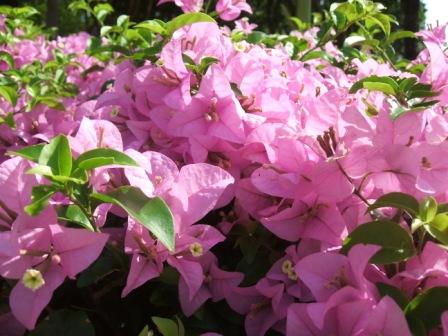
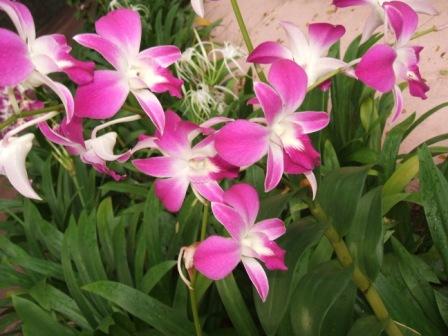
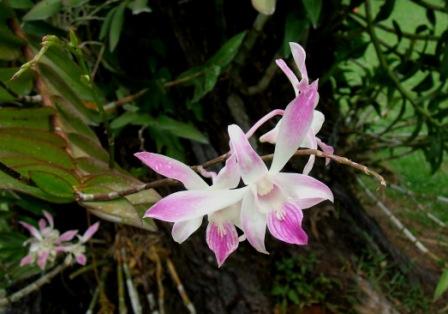
bougainvillea;
ubiquitous orchid; Singapore National Orchid: Miss
Joachim
The mini bus arrives. Our luggage appears as if by magic. One of the
giant Sikhs, one I haven’t seen before with startling light eyes,
shakes my hand till the bones grate against each other, and wishes us a
good journey. Come again he
says. In that moment, I really believe I might.
The airport routine, once tackled with mounting excitement, has become
tedious over the weeks, but this time we are travelling to our own
country so at least the form filling is absent. I’m cheered up by a
text from Ben about Mothers Day which falls the day after our return. He
is going to cook for us. It carries me through the wait.
The plane is on time and familiar, British Airways. Soon we are airborne
and the lights of
Singapore
fall away beneath us. It is one of the most uncomfortable flights we
have ever had, with turbulence for about three quarters of the time,
quite bone shaking. In spite of this, we sleep a lot of the time, as
good a way as any of passing 13 hours.
We don’t eat dinner, preferring to sleep, but after several hours I
start to feel peckish and breakfast is a long way off. By chance I
discover that Tuck Boxes are laid out in the galley and we can help
ourselves to crisps and chocolate bars. Drinks are always available, so
I’m fortified until breakfast, which is never a happy meal on board.
Omelettes and scrambled eggs do not reheat well and bacon goes soggy,
and the breakfast roll I look forward to turns out to be a croissant.
I’ve never got on terms with croissants, they are generally greasy and
nasty. The fruit and yogurt go down ok, and I resolve to have a second
breakfast when I get home. Ben will be proud of me; he and Gordon on
their exploring days, get up so early they find themselves having second
breakfast somewhere along the way.
Harvey
discovers he has packed his English money and the door key. He finds an
ATM in the airport, and we’ll have to either knock up TandeM or find
the spare key where we hid it years ago.
The last lap of our journey goes relatively smoothly. As we are waiting
for our luggage in baggage claim,
Harvey
’s mobile rings. Our ride home is waiting. We’ve done something
we’ve not done before, paid for a car to take us door to door. It’s
a luxury I appreciate at 5.30 am. after a 13 hour flight and 4 weeks
away.
Greenmead looks quiet and peaceful when we arrive. The spare key is
where
Harvey
remembered, and we let ourselves in. Home. After all the magic of our
amazing trip, right now Home is the most magic of places.
|